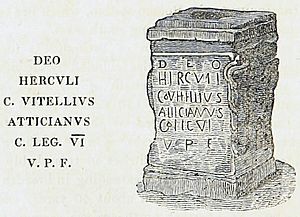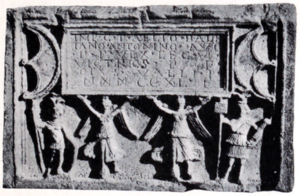Legio VI Victrix facts for kids
Quick facts for kids Legio VI Victrix |
|
|---|---|

|
|
| Active | 41 BC to after 2nd century |
| Country | Roman Republic and Roman Empire |
| Type | Roman legion (Marian) |
| Role | Infantry assault (some cavalry support) |
| Size | Varied over unit lifetime. |
| Garrison/HQ | Perusia (41 BC) |
| Nickname(s) | Victrix, "Victorious" |
| Engagements | Perusia (41 BC) Cantabrian wars (29–19 BC) |
| Commanders | |
| Notable commanders |
Galba |
The Legio VI Victrix was a famous Roman legion. Its name means "Victorious Sixth Legion." This powerful army unit was started in 41 BC by Octavian. He later became Rome's first emperor. The Legio VI Victrix was like a twin to another legion, the VI Ferrata. Some of its soldiers might have come from that older legion.
Contents
Early Battles of the Sixth Legion
The Legio VI Victrix first fought in a battle at Perusia in 41 BC. This was a city in Italy. Later, the legion helped fight against Sextus Pompeius. He was a powerful enemy who controlled Sicily. He threatened to stop sending grain, which was food, to Rome. In 31 BC, the legion also took part in the Battle of Actium. This was a big naval battle against Mark Antony.
The Legion's Imperial Adventures
The Sixth Legion in Spain
The Legio VI Victrix played a big part in the Roman takeover of Hispania (modern-day Spain). They fought in a major war against the Cantabrians from 29 BC to 19 BC. This war helped Rome control all of the Iberian Peninsula.
The legion stayed in Spain for almost 100 years. They even got the nickname Hispaniensis because of their time there. They also helped found the city of Legio, which is now León. Soldiers from this legion and Legio X Gemina were among the first people to settle in Caesaraugusta. This city is now Zaragoza. The legion earned its nickname Victrix (Victorious) during the time of Emperor Nero. But Nero was not very popular. So, when Galba, the governor of the area, decided to try and remove Nero, the legion supported him. Galba was then declared Emperor by the soldiers of Legio VI Victrix.
The Sixth Legion in Germany
For a short time, from about 110 AD to 119 AD, the legion was stationed in Germania Inferior. This was a Roman province along the Rhine river.
The Sixth Legion in Britain


In 119 AD, Emperor Hadrian moved the legion to northern Britannia. They were sent to help other legions stop local resistance. The Legio VI Victrix was very important in winning these fights. They eventually took the place of the Ninth Legion at Eboracum (modern-day York). In 122 AD, the legion started building Hadrian's Wall. This wall helped keep the peace for about 20 years.
Twenty years later, the legion also helped build the Antonine Wall. This wall had forts like Castlecary and Croy Hill. However, the Antonine Wall was mostly left by 164 AD. In 2020, a copy of a special stone, called the Eastermains stone, was put up in Twechar. The original stone was found on a farm near Kirkintilloch. It is similar to two other stones from the Sixth Legion found on the Antonine Wall.
In 175 AD, the Roman emperor, Marcus Aurelius, defeated a tribe called the Iazyges. He brought 5,500 of them to Britain. Some people have said that some of these new people joined Legio VI Victrix in York. However, there is no clear proof of this. The only group of these new people known to be in Britain was at Ribchester.
The Legio VI was given an special title, "Britannica," by Emperor Commodus in 184 AD. This was after he took the title himself.
In 185 AD, the Roman legions in Britain had a mutiny. This means they rebelled against their leaders. They wanted a commander named Priscus to replace the unpopular Emperor Commodus. But Priscus said no. The mutiny was stopped by Pertinax. He later became emperor himself after Commodus was killed.
The large fort at Carpow in Scotland was used by Legio VI from about 184 AD. They finished building the fort's main buildings. They even put tiles on the roofs that showed their new nickname.
A leader of the legion, Claudius Hieronymianus, built a temple to a god named Serapis in Eboracum (York). He did this before Emperor Septimius Severus arrived in 208 AD.
An altar, which is like a special stone table, was dedicated to the god Hercules. This was done by Gaius Vitellius Atticianus, a Centurion of the Legio VI Victrix, at Whitley Castle.
See the Legion Today
Some groups today like to pretend to be the Legio VI Victrix. They do this for fun and to teach people about history. This is called reenactment.
- One group is in Los Angeles.
- Another group is in Denmark and Sweden, called Legionord.
- Legio VI Victrix, Eboracum, does reenactments in York, England.
- The Antonine Guard in Scotland shows what a unit of Legio VI was like during the time of the Antonine Wall.
See also
 In Spanish: Legio VI Victrix para niños
In Spanish: Legio VI Victrix para niños
- List of Roman legions


